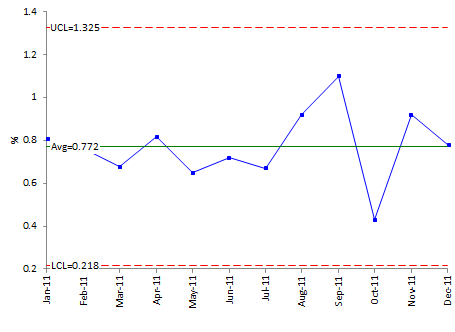

In this issue:
- Pay for Performance Example
- Four Assumptions That Are Seldom True:
- Recommendations
- Quick Links
Please feel free to leave a comment at the end of the newsletter.
Pay for Performance Example

Table 1: Production Cell Scrap
| Month | % Scrap |
| Jan-11 | 0.81 |
| Feb-11 | 0.76 |
| Mar-11 | 0.68 |
| Apr-11 | 0.82 |
| May-11 | 0.65 |
| Jun-11 | 0.72 |
| Jul-11 | 0.67 |
| Aug-11 | 0.92 |
| Sep-11 | 1.1 |
| Oct-11 | 0.43 |
| Nov-11 | 0.92 |
| Dec-11 | 0.78 |
Management believes that, if they have the right incentives in place, you will be able to do this. So, they have selected % scrap as one of the key performance indicators (KPIs) for your cell – along with uptime and tools produced. For each KPI, they have developed two goals. For scrap, the average for 2011 was 0.77%. So, management sets this as the first goal. Each month when the scrap is equal to or less than 0.77%, you will receive a bonus. The second goal is set at 0.65%. Each month when the scrap is equal to or less than 0.65%, you will receive an even larger bonus. Management will review the results at the end of this year and adjust the goals for next year. Nice of them, isn’t it?
What are management’s basic assumptions in setting up this type of system? These are really the same assumptions that management has for the most common example of pay for performance: sales commissions. These assumptions are:
- All people are motivated by money.
- We can use an incentive system to effectively motivate someone to do the job we want them to.
- There is a fair way of determining how much someone gets paid based on the work done by the individual.
- People have control of the system.
Unfortunately, these assumptions are often not valid. And management has ignored variation and the lessons from the red beads (remember the red beads? See this link for more information on the red bead experiment). We have written quite a few newsletter articles on variation. If you are new to this concept, you might want to start with this newsletter.
Let’s take a look at the four assumptions above.
All People Are Motivated by Money

Of course, people are interested in money. They want to be paid fairly for the work they do. But for people with satisfactory salaries, numerous studies have shown that the non-financial motivators are much more effective in motivating employees. There is a lot of data that show what motivates people most are the intangible things — interesting work, being creative, praise from management, etc. Often, financial reward systems give bursts of energy that result in short-term improvement with long-term negative impacts on the business.
Seldom do people change jobs for increases in pay. People normally change due to the lack of things on the job that make it challenging and rewarding. Dr. W. Edwards Deming said it over and over — money is not a motivator, it will not bring “joy on the job.”
Of course, the less money we make, the more concerned we are about money. We need to be able to buy the things we need to survive. So, one could assume that the “lower” a person is in the organization, the more concern about money he or she will have. Again, however, this not the primary source of motivation for the vast majority of the people.
Money is a motivator for everyone? We know it is not true yet we want to set up systems based on that incorrect assumption. I think Dee Hock, the man who built Visa, said it very well:
“Money motivates neither the best people, nor the best in people. It can move the body and influence the mind, but it cannot touch the heart or move the spirit; that is reserved for belief, principle and morality. As Napoleon observed, “No amount of money will induce someone to lay down their lives, but they will gladly do so for a bit of yellow ribbon.”
We Can Effectively Use an Incentive System to Motivate People to Do the Job We Want Them To
OK. So maybe money is not a big motivator to everyone. But can’t we design an incentive system to get people, particularly those who are lower in the organization, to do what we want them to. So, is it different with people who are “low” in the organization? What about you in your production cell? Will you work harder if we put a “carrot” out there? The following appears to be what management thinks:
Hmm, kind of makes sense, right? After all, they aren’t compensated like salespeople or managers, for example. They would like more money, pay off some of their bills. Plus, we can set up the system to get them to focus on what we want them to do – less scrap, more tools, and more uptime. Pay them more, either individually or as a team, when they reach the goal. Let’s reward them when they do good work.

a. Rewards Punish
Can this be true? Unfortunately yes. Rewards are aimed at controlling someone’s behavior. If you do this, I will give you something you like. While the reward may be pleasurable, people do not like to be controlled. In addition, we may not get all the reward we think we are due. In this case, the reward becomes a punisher. “Rewards feel punitive because they too amount to an effort to manipulate people’s behavior. Moreover, employees may find a bonus or other incentive deliberately withheld or withdrawn from them, or else they may simply fail to obtain it despite their best efforts.” Remember the red beads? It was impossible to get all white beads – people failed despite their best efforts.
b. Rewards Rupture Relationships
Individual rewards will definitely rupture relationships that exist. It will foster competition, not cooperation. There is only one best — everyone else is a loser. A sure fire way to destroy teamwork is to make the people compete against each other for a bonus. In addition, it likely to change the relationship between supervisor and employee. If the supervisor determines the bonus, the employee may not tell him/her certain things. Teamwork once again fails.
c. Rewards Ignore Reasons
This is a big one in my opinion. To improve, we must know what causes problems. The use of rewards, even those tied to process improvement, tend to hinder the search for real reasons of problems. In fact, this reward process allows management to ignore their true job of coaching and helping. The assumption is that if we pay them enough, the job will get done. Then we don’t have to lead them — simply offer the carrot.
d. Rewards Discourage Risk-Taking
People will do what it takes to the get reward, but only what it takes. Having a sliding scale does not change that. In addition, people will not take any risks that could affect the reward.
e. Rewards Undermine Interest
This is the biggest issue here. Intrinsic motivators are more powerful than extrinsic. However, “extrinsic motivators not only are less effective than intrinsic motivation, but actually reduce intrinsic motivation.” In other words, rewards, like incentives, can hurt the person’s motivation for doing the activity. The focus changes from the activity to the reward. I am reminded of the story of the boy who began helping his mother do dishes each night. He loved to help her. One night, she told him how much she appreciated his help and gave him a quarter. The next night, the mother started to wash the dishes. Her son sat at the table. She asked why he wasn’t helping. His answer: where is my quarter?
There is a Fair Way of Determining How Much Someone Gets Paid Based on the Work Done by the Individual
OK, so money is not a big motivator and it may be difficult to set up an incentive system that doesn’t ultimately demotivate people. But, let’s do it anyway. How can we design a system to pay people for the work done — either individually or as a team?
As Dr. Deming pointed out, you can’t design such a system. It is impossible to separate out the contribution of an individual or team to the process’s output from the contribution of the system. For example, let Z be the output we are interested in measuring and rewarding a person or team on. Let it be the number of tools produced by your production cell. Let X be the contribution of you or your team to the process. Let Y be the contribution of the system to the process. By system, I mean the processes involved in production, the type of supervision, the layout of the plant, etc. The equation for tools produced is then
X + Y = Z
Suppose Z is 1000 tools produced. What is your contribution to that? The equation above cannot be solved for a unique value of X or Y. It is impossible to separate the two.
So people might say that is not a big deal. Just forget about the system’s input. Ever know somebody who did a poor job in one department, then was moved to another and became a great performer? Of course, we all do. The person was the same in this case. Why the difference? The system of course. Maybe it was supervision. What does supervision add to the process?
People Have Control of the System
People do not have control of the system. This is one point that Dr. Deming often spoke of – people work in the system; management works on the system. Once a process is in statistical control, the workers are doing the best they can. Only common causes of variation are present. The only way to improve the process is to fundamentally change the process. This is management’s responsibility – even though the workers may have great ideas on what needs to be done. They just don’t have the authority to make those changes.
The control chart on the scrap data is shown below. The process is in statistical control. You are doing all you can on scrap. You will hit the first level for the bonus of .77 about half the time. You may also hit the second level of bonus of 0.65 a couple of times during the year. All with the current process.
Figure 1: Production Cell Scrap Control Chart

The process has to be fundamentally changed for real improvement to occur. Of course, one way to reduce scrap is to distort the data – simply not scrap tools that need to be scrapped. You wouldn’t do that, would you? Just for a few extra dollars? Not quite what management had in mind, is it?
Recommendations
Intrinsic motivation is a far better motivator than rewards such as bonuses and incentives. The key is to make the work the motivator and try to keep the pay from being a demotivator.
Basically, the pay system should be fairly simple. Brian Joiner suggests a simple system in his book Fourth Generation Management. Pay a salary that is in line with the market for the job. You don’t want to be below the average, but not too far above it either. This is fair to people. They know you are paying them about what they could make elsewhere. They will not leave due to pay issues if this is the case.
Give the same percentage salary increase to all employees once a year. The increase is to keep people’s salaries in line with the market and is not related to how the company is doing.
When the company is doing well, share with the people. For people who have been with the company for a certain time frame, give them each a certain number of weeks of pay. Prorate it for people who have not been with the company long enough (for example, two years). There will be times when the company will not have money to share.
Some people may require some special adjustments to salary, but the above simple system is fair and people will sense that it is fair to everyone involved – one that takes into account that we are all part of the same system.
Great stuff. Also timely: there's a lot of unease [to put it mildly] around now about bonuses for bankers etc. so it's good to put Dr. D's message out there again. Also nice to have Brian Joiner's contribution included – helpful and straightforward.
Thanks,
Alan Hodgson
Excellent article!
In our profession, it’s critical that we don’t overlook the human dimensions (unless you happen to just deal with machines or computers all day). Reading this article reminded me of Colin Powell’s definition: “Leadership is the art of accomplishing more than the science of management says is possible.”
Thanks for shifting our focus beyond the spreadsheet to consider what is behind the numbers.
Ray Quiñones
Thank you so much for this arctile, it saved me time!
Another most excellent analysis and discussion of this area is Peter Scholtes' Chapter 9 in _The Leader's Handbook_ – it hits every myth and management misconception. 🙂
*** Wayne G. Fischer ***
Thanks Wayne. Scholtes' book is excellent.